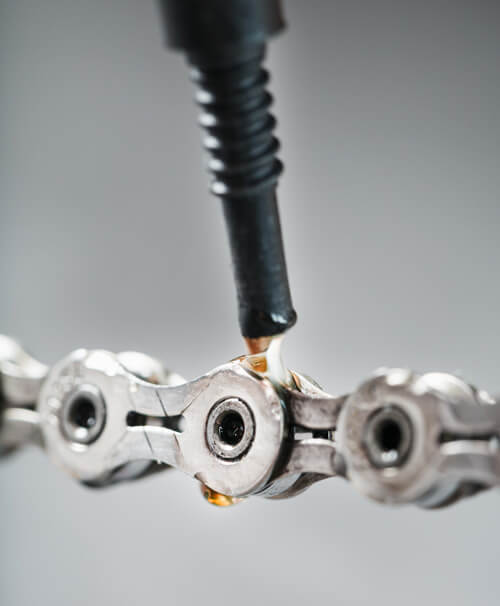
Why should I clean my bike chain?
If your bike is making weird noises, it might be time to clean your chain. Because if your chain and gears are covered in muck, it won’t matter as much how well-tuned they are. Each pedal stroke will be less efficient than the last, and the sound of metal on metal isn’t exactly harmonious. So grab some degreaser or solvents, and use these tips to clean your bicycle chain in no time.
How to clean your bike chain?
Your bike’s drivetrain is the most important part to keep clean because this is where all the dirt and grime settle. Start with a basic hose down and use low-pressure water from a hose to clear any larger debris (like sticks) that might be on your frame. Then, rotate the chain and lightly spray it with a little water from every angle.
Next, get a bucket and fill it with some warm, soapy water — and grab an old toothbrush. Gently scrub the drive train with the soapy toothbrush as you continue to rate the chain. This will help you get in all the little cracks and crevices. Once your chain is looking like new, you’re ready to move on to the degreasing step.
How Often Should You Clean Your Bike Chain
You should degrease, clean, and lube your bike chain every month or so, depending on how frequently and where you travel. If you spend a lion’s share of time on the normal tidy road, you can keep your vehicle’s vital mechanisms tidy by riding it backward through a lint-free cloth.
This simple and easy procedure may be performed whenever you choose, particularly before applying more lubrication. Remember that you should take good care of your iron horse by giving it a good cleaning after each off-road ride.
Professional bike cleaners are available at most bike shops if you feel your traveling best mate needs a good scrub down, and this is particularly true if a reputable brand constructed your vehicle.
Cleaning, degreasing, and re-lubing your bike’s mechanisms and parts at least once every 100 to 150 kilometers (60-90 miles) is highly recommended. You may think that your chain is tidy. However, tidying it after each ride is better just to be sure.
How to Clean a Bike Chain with Household Products
Dishwashing Solution
Considering how cheap and widely accessible dish soap is, it is the obvious and sensible choice. Brush the chain with dish soap to dislodge gunk and then wipe it off with a towel dipped in degreaser to get rid of any leftover material. The citrus-scented degreaser is safe to use, won’t damage your bike’s paint job, and will leave behind a lingering aroma. Window frames and barbecues are just two more oily places dish soap may be put to good use. Do not use your bike or any other greasy equipment again until the dish soap has dried fully.Brushes
Use brushes with firm bristles designed for this purpose to perform bike chain maintenance. To thoroughly remove the grime and debris from the chain, you will need to do this procedure many times.Old Clothing
To clean the chain, you may use many layers of old t-shirts, but be aware that this method may leave some residue behind.
To remove the remaining grease, place a dry towel or old shirt over the chain and spray it with a degreaser. Though simple to whip up, effective DIY degreasers need a few key components: petroleum jelly, mild soap flakes, bicarbonate of soda (baking soda), vinegar, lemon juice, or spirits. Fat and oil are easier to remove with softsoap flakes that won’t corrode your metal.
The Use of DIY Degreasers
Instead of using a store-bought degreaser, you might use oven cleaner. This single-step chemical cleaner does a great job of clearing the chain of filth, while its pleasant aroma is not great for those with hypersensitive noses. To clean a chain with oven cleaner, remove any remaining filth by washing it in hot water with dish soap, then scrub the chain well using a stiff brush designed for this purpose. Before using the chain again, make sure it has dried well.
How to Derust a Bike Chain
If you are worried about rusting just on your chain, you should start by giving it thorough oiling with some bike chain lubricant. Chain oil, a cloth wipedown, and some riding time may be all it takes to remove the first layer of surface rust.
Oiling a chain properly requires patience as you carefully apply a drop of oil to each link and then wipe it clean with a towel. It will take some time to do it to the whole chain. Some people believe that all you have to do to grease a chain is spray some oil on it, and you’re good to go. Keeping the chain lubed without soaking it is a challenge. Thus, attention to detail is required.
Chain lubes come in the form of a paste or wax rather than an oil. These are preferable to outside solutions since you will not have to deal with oil splatters on your work surface.
If you have had chain rust, give this a go; there is a strong chance it will fix the issue.
We have found that WD-40, a true multi-tasking chemical, works wonders on bikes that have developed rust. Especially when dealing with a chain in dire need of our attention, we always keep it on hand as a backup plan.
But there are two schools of thought regarding using WD-40 on bicycle chains. Many people enjoy it, while others hate it.
The thing to remember about WD-40 is that it is more of cleaning and not so much of a lubricant. So, if you need to remove rust from metal components, it works well, particularly if the rust is just on the surface. Keep in mind that if you use it on a chain, you will still need to follow up with a more traditional chain lubricant or oil.
How to degrease your bike chain?
Grab some degreaser to get rid of all the dirt you couldn’t get with the soap and toothbrush. Think of this like mopping after you vacuum a floor — it might not look dirty until you see the dirty water.
Start by rotating the chain again, but this time move it backward in the opposite direction and put a little degreaser on each and every link.
Once the chain has been fully saturated with a degreaser, let it sit and dry for a while. When it’s dry, use a cloth to remove all the degreaser and dirt — as you continue to rotate the bike chain backward.
You’ll know you’ve gotten everything clean if you’re able to rotate the bike chain and you don’t feel any grittiness. It should feel smooth and well-oiled as you rotate it.

How to lube a bike chain
Bicycle chain lubricant, chain oil, or chain lube keep your chain moving smoothly and prevent rust. It’s an important step and luckily it only takes a few minutes. First, make sure your bike chain is completely dry. You can use an air compressor to double-check that every link is free of water.
Then, take a little bit of your chain oil and put a thin, even coating along your chain. If your oil bottle has a drip cap, make sure to use it so you don’t spill everywhere or apply too much.
Once you’ve lubricated each bike chain link, you can rotate the cranks to further saturate the chain. Then rotate the chain backward and lightly dry the chain with a cloth.
After you’ve cleaned your bike chain …
Now that your bike chain is cleaned, degreased, and lubricated, you can give the rest of your bicycle a quick once over. Use a cloth to catch any leftover oil or lubricant on the frame or tires.
Remember that bicycle maintenance keeps your bike alive and well for longer! Revisit these tips every month or so depending on how often you ride to keep everything running smoothly.
Supplement your bicycle maintenance with a bike insurance policy starting at just $8 a month. It’s affordable and easy to build your own coverage, and you can insure your bike at its full value. Get a quote today. It’s fast, it’s easy, and it’s free!
